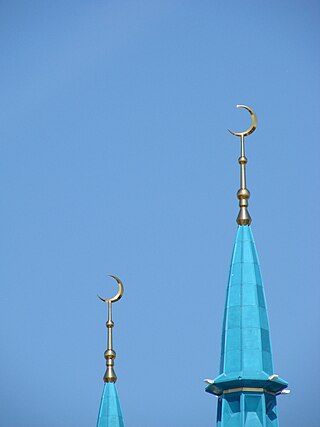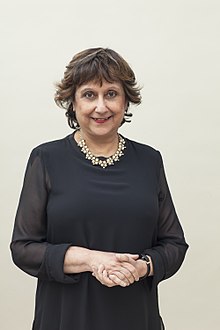Blasphemy, as defined in some religions or religion-based laws, is an insult that shows contempt, disrespect or lack of reverence concerning a deity, an object considered sacred or something considered inviolable. Some religions regard blasphemy as a religious crime, especially the Islam including insulting the Islamic prophet Muhammad in Islam, speaking the "sacred name" in Judaism, and the "eternal sin" in Christianity.

Christianity and Islam are the two largest religions in the world, with 2.8 billion and 1.9 billion adherents, respectively. Both religions are considered as Abrahamic, and are monotheistic, originating in the Middle East.

Islamic–Jewish relations comprise the human and diplomatic relations between Jewish people and Muslims in the Arabian Peninsula, Northern Africa, the Middle East, and their surrounding regions. Jewish–Islamic relations may also refer to the shared and disputed ideals between Judaism and Islam, which began roughly in the 7th century CE with the origin and spread of Islam in the Arabian peninsula. The two religions share similar values, guidelines, and principles. Islam also incorporates Jewish history as a part of its own. Muslims regard the Children of Israel as an important religious concept in Islam. Moses, the most important prophet of Judaism, is also considered a prophet and messenger in Islam. Moses is mentioned in the Quran more than any other individual, and his life is narrated and recounted more than that of any other prophet. There are approximately 43 references to the Israelites in the Quran, and many in the Hadith. Later rabbinic authorities and Jewish scholars such as Maimonides discussed the relationship between Islam and Jewish law. Maimonides himself, it has been argued, was influenced by Islamic legal thought.

Marc Quinn is a British contemporary visual artist whose work includes sculpture, installation, and painting. Quinn explores "what it is to be human in the world today" through subjects including the body, genetics, identity, environment, and the media. His work has used materials that vary widely, from blood, bread and flowers, to marble and stainless steel. Quinn has been the subject of solo exhibitions at Sir John Soane's Museum, the Tate Gallery, National Portrait Gallery, Fondation Beyeler, Fondazione Prada, and South London Gallery. The artist was a notable member of the Young British Artists movement.

Religious philosophy is philosophical thinking that is influenced and directed as a consequence of teachings from a particular religion. It can be done objectively, but it may also be done as a persuasion tool by believers in that faith. Religious philosophy is concerned with the nature of religion, theories of salvation, and conceptions of god, gods, and/or the divine.
Liberalism and progressivism within Islam involve professed Muslims who have created a considerable body of progressive thought about Islamic understanding and practice. Their work is sometimes characterized as "progressive Islam". Some scholars, such as Omid Safi, differentiate between "Progressive Muslims" and "Liberal advocates of Islam".

Sir Michael Craig-Martin is an Irish-born contemporary conceptual artist and painter. He is known for fostering and adopting the Young British Artists, many of whom he taught, and for his conceptual artwork, An Oak Tree. He is an Emeritus Professor of Fine Art at Goldsmiths. His memoir and advice for the aspiring artist, On Being An Artist, was published by London-based publisher Art / Books in April 2015.
Criticism of Islam is questioning or challenging the beliefs, practices, and doctrines of Islam. Criticism of Islam can take many forms, including academic critiques, political criticism, religious criticism, and personal opinions.
John Aubrey Clarendon Latham, was a Northern Rhodesian-born British conceptual artist.

Islam is an Abrahamic, monotheistic religion centered on the Quran and the teachings of Muhammad, the religion's founder. Adherents of Islam, called Muslims, number approximately 1.9 billion globally and are the world's second-largest religious population after Christians.
Muslim scholars have developed a spectrum of viewpoints on science within the context of Islam. The Quran and Islam allows much interpretation when it comes to science. Scientists of medieval Muslim civilization contributed to the new discoveries in science. From the eighth to fifteenth century, Muslim mathematicians and astronomers furthered the development of almost all areas of mathematics. At the same time, concerns have been raised about the lack of scientific literacy in parts of the modern Muslim world.
The Abrahamic religions are a group of religions, most notably Judaism, Christianity and Islam, centered around the worship of the God of Abraham. Abraham, a Hebrew patriarch, is extensively mentioned in the religious scriptures of the Hebrew and Christian Bibles, and the Quran.

Interactions between the followers of Islam and Hinduism began in the 7th century, after the advent of the former in the Arabian Peninsula. These interactions were mainly by trade throughout the Indian Ocean. Historically, these interactions formed contrasting patterns in northern and southern India. While there is a history of conquest and domination in the north, Hindu-Muslim relations in Kerala and Tamil Nadu have been peaceful. However, historical evidence has shown that violence had existed by the year 1700 A.D.

Gambia is a Muslim majority country, with Muslims constituting 96.4% of the population, some 3.5% are Christian, and 0.1% practice other religions.

Ahmadiyya, officially the Ahmadiyya Muslim Community or the Ahmadiyya Muslim Jama'at, is an Islamic revival or messianic movement originating in Punjab, British India, in the late 19th century. It was founded by Mirza Ghulam Ahmad (1835–1908), who claimed to have been divinely appointed as both the Promised Mahdi and Messiah expected by Muslims to appear towards the end times and bring about, by peaceful means, the final triumph of Islam; as well as to embody, in this capacity, the expected eschatological figure of other major religious traditions. Adherents of the Ahmadiyya—a term adopted expressly in reference to Muhammad's alternative name Aḥmad—are known as Ahmadi Muslims or simply Ahmadis.

The Shahada, also transliterated as Shahadah, is an Islamic oath and creed, and one of the Five Pillars of Islam and part of the Adhan. It reads: "I bear witness that there is no deity but God, and I bear witness that Muhammad is the Messenger of God."
Prophets in Islam are individuals in Islam who are believed to spread God's message on Earth and to serve as models of ideal human behaviour. Some prophets are categorized as messengers, those who transmit divine revelation, most of them through the interaction of an angel. Muslims believe that many prophets existed, including many not mentioned in the Quran. The Quran states: "And for every community there is a messenger." Belief in the Islamic prophets is one of the six articles of the Islamic faith.

Allah as a Lunar deity refers to a historical postulation, now debunked, that "Allah" originated as a moon god. The claim first arose in 1901 in the scholarship of archeologist Hugo Winckler, who identified the name Allah with a pre-Islamic Arabian deity known as Lah or Hubal, which he called a lunar deity.
Islamic teachings on humanity and human welfare have been codified in its central religious book known as the Quran, which the Muslims believe was revealed by God for the humankind. These teachings have often been exemplified by Islamic prophet Muhammad as displayed in his sayings and practices. To the Muslims, Islam is what the Quran has instructed to do and how Muhammad has put them into practice. Thus, the understanding of any Islamic topic generally rely on these two.
In Islam, morality in the sense of "non practical guidelines" or "specific norms or codes of behavior" for good doing, are primarily based on the Quran and the Hadith – the central religious texts of Islam – and also mostly "commonly known moral virtues" whose major points "most religions largely agree on". They include kindness, charity, forgiveness, honesty, patience, justice, respecting parents and elders, keeping promises, and controlling one's anger, love of God and those God loves, love of his messenger (Muhammad) and of believers.













